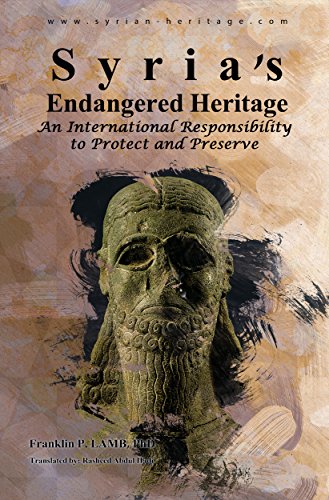Another project would carry out far more detailed scans of antiquities in Syria using laser scanners. The scanners bounce lasers off the surface of objects in the field, measuring millions of points a second to create a data set known as a point cloud. The data can be used to create 3-D images accurate to two or three millimeters to create models or virtual tours of the sites or allow full-scale reconstructions. This project, called "Anqa," the Arabic word for the phoenix, the legendary bird that rises from the ashes, aims to laser-scan 200 objects in Syria, Iraq and other parts of the region, according to the California-based scanning company CyArk. It hopes to work with DGAM and other antiquities agencies in Syria, as well as UNESCO, to deploy teams in Damascus and other accessible areas.
A recently launched campaign is taking a more low-tech approach aiming at directly protecting at least some sites. The project, by the American Schools of Oriental Research (ASOR), provides supplies and funding to local experts and volunteers for crates and other items to store artifacts and also sandbags to pack around unmovable structures to give some protection against shelling or bombs. This, according to LeeAnn Gordon, project manager for Conservation and Heritage Preservation at ASOR also using satellite images to track destruction of antiquities. One problem this initiative has to deal with is that US policy toward Syria prohibits the funding of governmental groups, thus limiting ASOR's options in a country divided between government-controlled, and jihadist held areas.
We can all help raise awareness in our communities and instruct our politicians to tighten and enforce current national and international laws and to ratify the instruments of international humanitarian law that protect cultural heritage. Specifically the Convention for the Protection of Cultural Property in the Event of Armed Conflict (The Hague 1954) and its two Protocols (1954 and 1999), as well as the Convention on the Means of Prohibiting and Preventing the Illicit Import, Export and Transfer of Ownership of Cultural Property (Paris 1970); to implement them swiftly and efficiently into national legislation and in accord with their spirit and overarching goal to preserve cultural heritage, and to observe and enforce them.
Irina Bokova, the Director of UNESCO has called on governments to implement the U.N. Security Council's Resolution 2199 which was adopted in February of this year and lays out serious penalties for the illegal importation of antiquities trafficked from regions under cultural threat.
Traveling around Syria one comes upon many heritage unfunded preservation projects through the initiative of local private citizens who love their country and want to preserve the cultural heritage of all of us. Some are reportedly being accomplished in rebel held areas where there is little technology and no resources. One of countless examples is the work of a history teacher, Suleiman al-Eissa who lives in Busra Sham, one of UNESCO's six World Heritage sites in Syria. As reported recently by the AP, Suleiman al-Eissa, a history teacher leads a self-created "revolutionary" antiquities department to protect the ruins in his hometown of Busra Sham in southern Daraa province one of the six UNESCO World Heritage sites. Mr. Al-Eissa, like many Syrians, is documenting in writing current damage at local archeological sites while guarding some sites from looting.
We can and must support new dedicated groups like Heritage for Peace and the more than two dozen NGO's recently formed that are working to protect archeological sites in Syria and Iraq. In each of our communities we can work on strengthening our national capacities, training for soldiers, more resources, experts on the ground, and better coordination with armed forces, Interpol, and other actors while encouraging volunteer organizations willing to send international volunteers experts as Cultural Heritage Monitors on the scene. Their work would be to assess, protect, and investigate cultural property destruction and looting. All this while working with locals of all religions and ethnicities who want to protect our and their cultural heritage. In other words we need to establish the cultural equivalent of the Red Cross and Blue Shield providing an emergency response to cultural property at risk from armed conflict.
As Dr. Emma Cunliffe, an archeologist at Oxford University pointed out recently: "Today's Monument's Men are often volunteers. Some are local people, such as the Syrian Association for Preserving Heritage and Ancient Landmarks, who work in Aleppo (a UNESCO World Heritage
City) to try and save the monuments and buildings there during the current conflict. In 2006, America formed a Committee of the Blue Shield, a group of individuals committed to the protection of cultural property worldwide during armed conflict. The UK Committee was established last year, and other committees are located across the world."
And there are many others.
The growing global groundswell of popular support spawning an international volunteer movement to confront and expel the non-state actors endangering our cultural heritage in Syria is cause for hope. And it's a clarion call for each of us to join the growing public support for confronting 'looting to order' and 'cultural racketeering' in Syria to preserve and protect our shared culture heritage for those who follow us.
(Note: You can view every article as one long page if you sign up as an Advocate Member, or higher).





